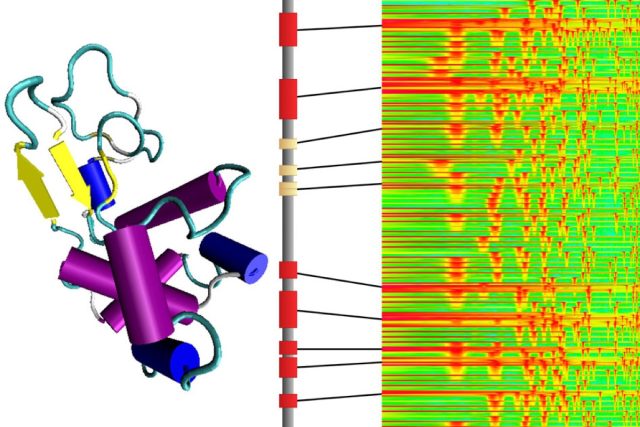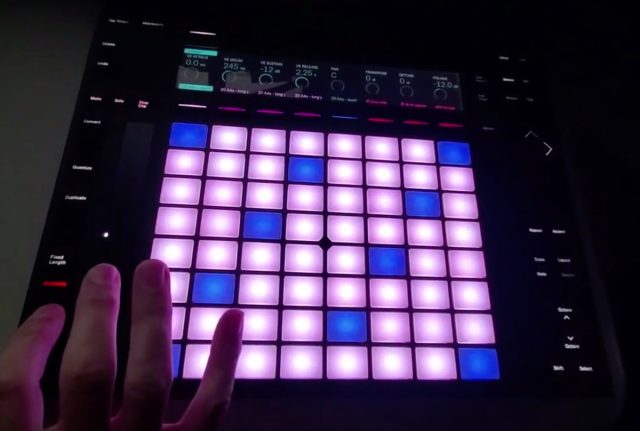Nearly seven years ago, MIT scientists mapped the molecular structure of proteins in spider silk threads onto musical theory to produce the "sound" of silk in hopes of establishing a radical new way to create designer proteins. That work even inspired a sonification art exhibit, "Spider's Canvas," in Paris last fall. Artist Tomas Saraceno worked with MIT engineers to create an interactive instrument inspired by the web of a Cyrtophora citricola spider, with each strand in the "web" tuned to a different note. [corrected]
Now MIT materials engineer Markus Buehler and his colleagues are back with an even more advanced system of making music out of a protein structure—and then converting it back to create novel proteins never before seen in nature. The team also developed a free app for the Android smartphone, called the Amino Acid Synthesizer, so users could create their own protein "compositions" from the sounds of amino acids. They described their work in a new paper in ACS Nano.
Much like how music has a limited number of notes and chords and uses different combinations to compose music, proteins have a limited number of building blocks (its 20 amino acids) which can combine in any number of ways to create novel protein structures with unique properties. Furthermore, "Any genre of music has patterns," said Buehler. "You'll see universality in terms of sound, the tones, but you also see repetitive patterns, like motifs and movements in classical music. These kinds of patterns are also found in proteins."
"Any genre of music has patterns. These patterns are also found in proteins."
The ability to tailor materials with so-called "tunable" properties would enable scientists to create better synthetic versions of natural materials like spider silk, which has a number of excellent properties. It's incredibly strong—ounce for ounce, it's stronger than steel or Kevlar, although it's not as strong as fibers spun from carbon nanotubes. It's waterproof, and it's able to stretch 30-40% before it breaks, compared to 8% for steel fibers and around 20% for nylon fibers. It may even have antimicrobial, blood-clotting, and other wound-healing properties. Since it's the structure that gives any material its unique properties, scientists would like to understand more about the protein structure of spider silk, as well as other kinds of proteins.
That's what Buehler's lab set out to do several years ago, demonstrating that silk gets its properties from the highly ordered, layered protein structures alternating with densely tangled clumps of proteins. Next, they went beyond the properties of the protein molecules alone to investigate how they combine to form a network on a larger scale. In the process, they discovered that music theory, combined with category theory, could be an invaluable aid in predicting how well new variations of a given material will perform based on said protein structure.

It turns out that the hierarchical elements of music composition (pitch, range, dynamics, tempo) are analogous to the hierarchical elements of protein structure. Thus, "The mechanism of spinning fibers from proteins can be translated into music through a process that assigns a set of rules that governs the construction of the system," the authors wrote in a 2012 paper published in Nano Today. "This technique allows one to express the structure, mechanisms, and properties of the ‘material’ in a very different domain, ‘music.’"
This latest work takes advantage of recent progress in AI methods to make the analogy between sound, music, and proteins more rigorous, according to Buehler, creating a better system for translating a protein's sequence of amino acids into a musical sequence.
"Musical instruments work via the vibrations of wood, or metal, or animal skins. All music is based on the vibrational structure that they create," he said. "Any molecule, if you look at it at the nanoscale, has continuous vibrations. We realized that each of the amino acid building blocks, which make up the proteins, which in turn make up the hierarchical structures—each of these has a particular sound signature, like a fingerprint."
They assigned each amino acid a tone based on its natural resonant frequency—actually more akin to a chord, since amino acids vibrate at several overlapping frequencies. The different 3D structures of the molecules determined the duration of each tone. Since there are 20 amino acids, this produced a 20-tone scale. Some electronic keyboards allow the user to make up any scale they wish, and that's what the MIT scientists used to create a keyboard with only 20 keys. They used that data to create a playlist of the sounds of many different kinds of simple proteins, so an AI could learn what each sounded like.

"Our human brain is pre-wired to understand things in a certain way, and it's hard to forget all that and learn from scratch," said Buehler. "AI has never listened to any type of sound or music." The AI can also reverse the process and use that acquired knowledge to design new proteins, both variations on existing ones and entirely new ones. "I was astounded when I saw the data come back," said Buehler. "It reproduced so perfectly the patterns with the proteins."
In short, the team was able to compute the unique fingerprints of all the different secondary structures of proteins and make them audible via transposition. "It sounds very different from anything humans have used in history, because we haven't been able to hear that until now," said Buehler. "Only with the tools of modern quantum mechanics can we compute these spectra and sonify them."
Buehler has become so familiar with those unique signatures that he can tell the difference between certain amino acid sequences by ear—a beta sheet, or an alpha helix, for instance. The Android app lets users create their own protein compositions, recording them automatically, with the option to share via email. "You can play mutations and hear how different variants of proteins sound," he said. "You can even fold the protein you've created, or analyze it using other methods."
DOI: ACS Nano, 2019. 10.1021/acsnano.9b02180 (About DOIs).
Listing image by YouTube/American Chemical Society
reader comments
23